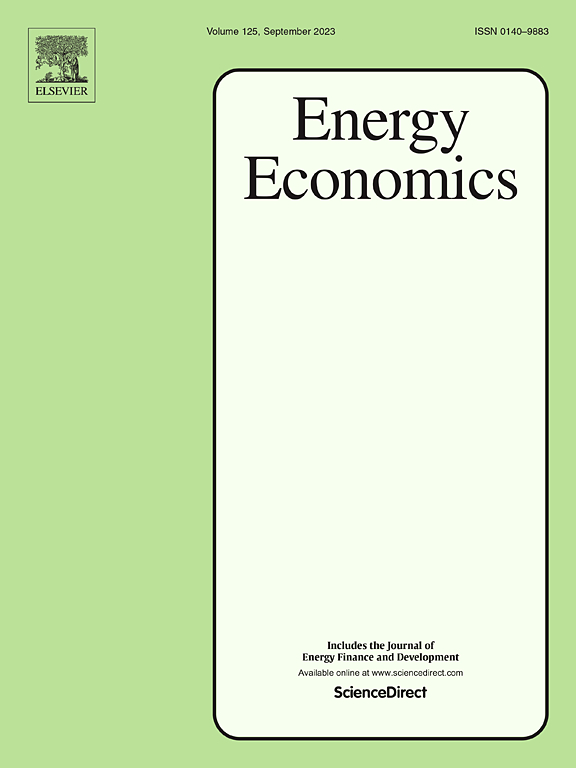Analysing a frequency and quantile connectedness spillover dynamics nexus: Metals, grains, and energy markets under economic signals
IF 13.6
2区 经济学
Q1 ECONOMICS
引用次数: 0
Abstract
In this study, we examine the impact of global economic indicators on connectedness spillovers among energy, metal, and grain commodity markets. Global economic indicators directly create a transmission channel to commodity markets by reflecting financial and trade fluctuations worldwide. Especially in tail regions, basic commodities such as energy, metal, and grain are affected by economic uncertainties, oil supply-demand, and economic policy uncertainty shocks. In particular, Copper emerges as the main net transmitter of shocks in both short- and long-term periods, while oil and gas prices are net shock receivers in the median and extreme right tail regions. This finding strengthens the narrative of the demand-side mechanism of oil prices. On the other hand, Copper and Nickel are clear shock transmitters in tail regions. These results emphasize the interconnectedness of commodity markets and the importance of short-term dynamics in shaping market behavior during downturns and upturns in market conditions. However, economic policy uncertainty significantly attenuates spillover connectedness across energy, metal, and grain commodity markets during periods of heightened complexity. This indicates that EPU disrupts cross-market linkages, leading to desynchronization in price transmissions. Conversely, the Baltic Dry Index and oil prices amplify spillover effects, reinforcing market integration through global demand channels. This finding strikingly indicates that energy, metal, and grain market interconnectedness increases, driven by global aggregate demand. In this context, our study supports the demand-side transmission narrative and provides evidence that economic policy uncertainty does not create momentum among connectedness spillover among energy, metal, and grain commodity markets.
频率和分位数连通性溢出动态关系分析:经济信号下的金属、谷物和能源市场
在本研究中,我们考察了全球经济指标对能源、金属和粮食商品市场连通性溢出效应的影响。全球经济指标通过反映全球金融和贸易波动,直接为商品市场创造了传导渠道。特别是在尾部地区,能源、金属、粮食等基础商品受到经济不确定性、石油供需、经济政策不确定性冲击的影响。特别是,无论是在短期还是长期,铜都是冲击的主要净发送者,而石油和天然气价格则是中位和极右尾部区域的净接收者。这一发现加强了油价需求侧机制的叙述。另一方面,铜和镍是尾部区域明显的震荡发射器。这些结果强调了商品市场的相互联系,以及短期动态在市场条件下行和上行期间塑造市场行为的重要性。然而,经济政策的不确定性显著削弱了能源、金属和粮食大宗商品市场在复杂性加剧时期的溢出连通性。这表明EPU破坏了跨市场的联系,导致价格传递的不同步。相反,波罗的海干散货指数和油价放大了溢出效应,通过全球需求渠道加强了市场一体化。这一发现令人震惊地表明,在全球总需求的推动下,能源、金属和粮食市场的相互关联性增强了。在此背景下,我们的研究支持需求侧传导的说法,并提供证据表明,经济政策的不确定性不会在能源、金属和粮食大宗商品市场的连通性溢出效应中产生动力。
本文章由计算机程序翻译,如有差异,请以英文原文为准。
求助全文
约1分钟内获得全文
求助全文
来源期刊

Energy Economics
ECONOMICS-
CiteScore
18.60
自引率
12.50%
发文量
524
期刊介绍:
Energy Economics is a field journal that focuses on energy economics and energy finance. It covers various themes including the exploitation, conversion, and use of energy, markets for energy commodities and derivatives, regulation and taxation, forecasting, environment and climate, international trade, development, and monetary policy. The journal welcomes contributions that utilize diverse methods such as experiments, surveys, econometrics, decomposition, simulation models, equilibrium models, optimization models, and analytical models. It publishes a combination of papers employing different methods to explore a wide range of topics. The journal's replication policy encourages the submission of replication studies, wherein researchers reproduce and extend the key results of original studies while explaining any differences. Energy Economics is indexed and abstracted in several databases including Environmental Abstracts, Fuel and Energy Abstracts, Social Sciences Citation Index, GEOBASE, Social & Behavioral Sciences, Journal of Economic Literature, INSPEC, and more.
 求助内容:
求助内容: 应助结果提醒方式:
应助结果提醒方式:


